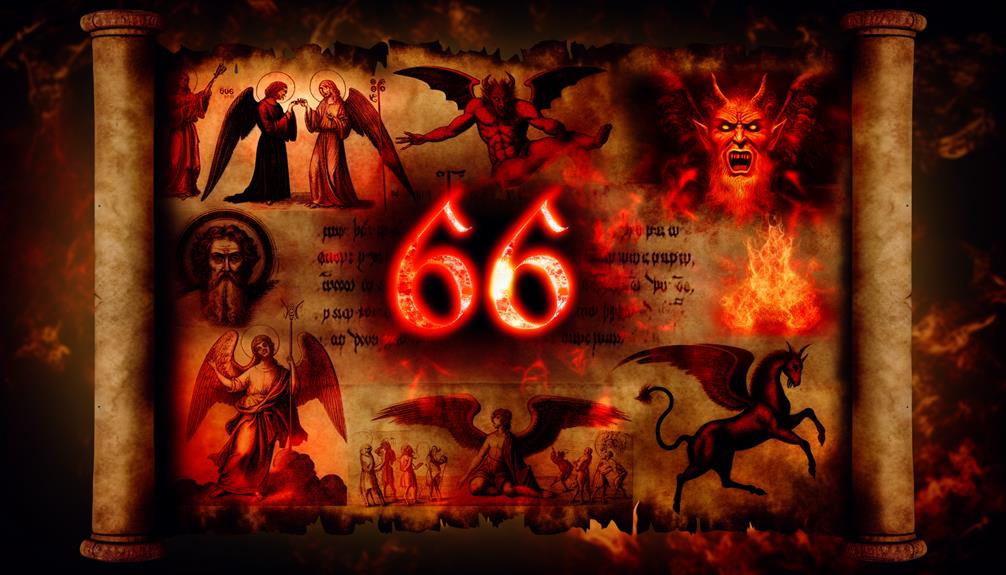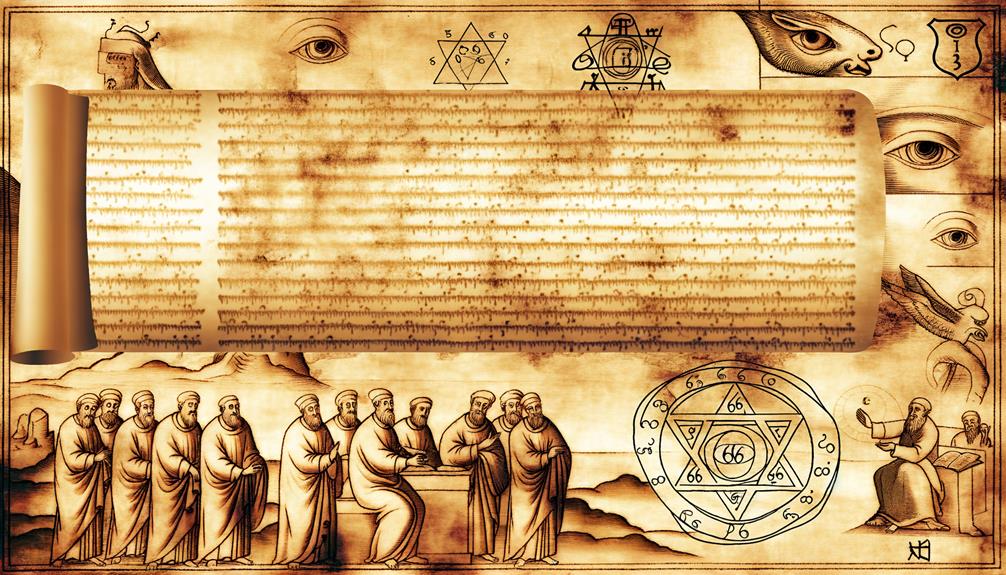Meaning of 666 in the Holy Bible: Symbol of Imperfection
In the Holy Bible, the number 666 is famously mentioned in Revelation 13:18 as ‘the number of the beast.’ This figure is laden with symbolic implications, often interpreted as representing human imperfection and sin, in contrast to the divine completeness signified by the number seven. Historical analyses have connected 666 to Roman emperors, particularly Nero, using gematria.
Its spiritual significance continues to be a subject of profound theological inquiry, reflecting early Christian struggles and eschatological anxieties. To uncover the multifaceted dimensions of this enigmatic number, one must consider its rich historical, theological, and cultural contexts.

Meaning of 666 in the Bible: The Mark of the Beast and Its Symbolism
| Aspect | Meaning |
|---|---|
| Biblical Reference | 666 is mentioned in Revelation 13:18 as the number of the Beast, often interpreted as a symbol of evil and opposition to God. |
| Symbolism of 666 | Represents imperfection and sin, falling short of the divine perfection symbolized by the number 7, which is associated with completeness in the Bible. |
| Mark of the Beast | The number is linked to the Beast, a figure of evil that will rise during the end times, symbolizing forces opposed to Christ and God’s kingdom. |
| Spiritual Significance | 666 is seen as a warning against false prophets, idolatry, and the temptation to follow worldly power rather than God. |
| Theological Interpretations | Some interpret 666 as a reference to historical figures (e.g., Emperor Nero) or systems that embody evil and corruption. |
| Apocalyptic Context | In the context of Revelation, 666 symbolizes the coming of the Antichrist and the final battle between good and evil before God’s ultimate victory. |
| Key Bible Verses | Revelation 13:16-18 (Description of the Beast and the number 666); Revelation 14:9-11 (Consequences of accepting the Mark of the Beast). |
Biblical Reference to 666

The number 666 is most famously referenced in the Book of Revelation, specifically in Revelation 13:18, where it is described as the ‘number of the beast.’ This passage has elicited extensive theological debate and interpretation.
In its immediate context, the verse calls for wisdom and invites the reader to calculate the number, suggesting a cryptic significance. Scholars generally agree that this number symbolizes imperfection and human fallibility, as it falls short of the divine number seven, which represents completeness and perfection in biblical numerology.
Additionally, some interpretations link 666 to specific historical figures through the practice of gematria, a method of assigning numerical value to words. This enigmatic reference continues to intrigue theologians and laypeople alike, inviting ongoing exploration.
Historical Context of Revelation

Understanding the historical context of the Book of Revelation is essential for interpreting its symbolic and apocalyptic content. Written during the late first century CE, Revelation reflects a period of intense persecution faced by early Christians under Roman rule. The author, John of Patmos, addresses seven churches in Asia Minor, offering both admonishment and hope. The political landscape, rife with emperor worship and hostility towards Christians, deeply influenced the text’s imagery and themes.
| Period | Contextual Factors | Impact on Revelation |
|---|---|---|
| 1st Century CE | Roman Persecution of Christians | Apocalyptic Tone |
| Asia Minor | Addresses to Seven Churches | Specific Admonishments |
| Emperor Worship | Conflict with Christian Beliefs | Symbolic Resistance |
This context is pivotal for decoding the nuances within Revelation’s visions and prophecies.
Symbolism of the Number 6

Symbolism of the number 6 in biblical texts often represents human imperfection and incompleteness, contrasting with the divine perfection symbolized by the number 7. This symbolic interpretation arises from several scriptural contexts and narratives.
The creation narrative in Genesis, where humanity is created on the sixth day, underscores this association. The number 6, falling short of 7, evokes a sense of human limitations and the inherent need for divine intervention.
- Human frailty and sinfulness
- Failure to achieve divine completeness
- Temporal existence without eternal fulfillment
- Striving without reaching divine perfection
This understanding provides a foundational context for interpreting the number 666, amplifying the concept of human imperfection to its utmost degree.
Interpretations by Early Church Fathers

Early Church Fathers provided interpretations of the number 666 that were deeply rooted in the symbolic historical context of their time, often linking it to the Roman Empire and its leaders.
Their analyses carried significant theological implications, as they connected the number to themes of imperfection and opposition to divine order.
These interpretations not only shaped early Christian eschatology but also influenced subsequent theological discourse on the nature of evil and the end times.
Symbolic Historical Context
The early Church Fathers provided a diverse array of interpretations regarding the symbolic significance of the number 666 in the Book of Revelation, reflecting the multifaceted nature of early Christian thought and its interaction with contemporary cultural and theological influences. Their exegeses often encompassed various dimensions:
- Political Critique: Some saw it as a veiled reference to oppressive Roman emperors, particularly Nero.
- Moral Allegory: Others interpreted it as a symbol of human imperfection and sinfulness.
- Numerological Significance: The use of gematria to decode hidden meanings.
- Apocalyptic Forewarning: Predictions of future tribulations and the Antichrist.
These interpretations not only elucidate the early Christian worldview but also underscore the richness of biblical symbolism.
Theological Implications Analyzed
Drawing from their diverse theological perspectives, early Church Fathers offered nuanced interpretations of the number 666, each reflecting a unique facet of early Christian doctrine and eschatology.
Irenaeus, for instance, associated 666 with the Antichrist, emphasizing its role in end-times prophecy. He viewed it as a symbol of imperfection, falling short of the divine completeness represented by the number seven.
Hippolytus expanded on this by linking 666 to specific historical figures, suggesting that it encoded the name of Nero Caesar, thereby contextualizing it within Roman persecution of Christians.
Origen, meanwhile, interpreted 666 allegorically, seeing it as a representation of human sinfulness and moral failure.
These varying interpretations collectively underscore the rich theological tapestry of early Christian thought.
Modern Theological Perspectives
Modern theological perspectives on the meaning of 666 often focus on symbolic interpretations, numerology, and prophecy, reflecting contemporary scholarly approaches that integrate historical context with modern insights.
Scholars today consider how the number 666 may symbolize broader themes such as imperfection or opposition to divine perfection, while also examining its role within apocalyptic literature.
These interpretations are further enriched by an analysis of numerological patterns and their prophetic implications, offering a multifaceted understanding of this enigmatic biblical reference.
Symbolic Interpretations Today
Contemporary theological scholars often explore the number 666 through various symbolic lenses, reflecting its complex role within modern Christian thought. This analysis often transcends literal interpretations, delving into the metaphysical and ethical implications of the number. Varied perspectives illustrate its multifaceted nature:
- Embodiment of Imperfection: Represents humanity’s inherent flaws.
- Symbol of Opposition: Identified as a counterforce to divine perfection.
- Allegory for Corruption: Seen as a metaphor for moral and spiritual decay.
- Cultural Reflection: Interpreted through the lens of contemporary societal issues.
These interpretations offer a rich tapestry of meanings, underscoring the profound and enduring impact of 666 in theological discourse. Some interpretations suggest that 666 represents the imperfection of humanity and its inability to reach the divine level. Others see it as a symbol of the struggle between good and evil, with the number representing the temptations and vices that lead people away from divine distinctions. Overall, the multitude of interpretations of 666 demonstrates the complexity and depth of theological thought and its ability to inspire ongoing contemplation.
Numerology and Prophecy
Building on these symbolic interpretations, the study of numerology and prophecy within modern theological perspectives further elucidates the enigmatic significance of 666 in biblical scripture. Numerology, the mystical relationship between numbers and events, has long been a tool for interpreting biblical texts. Contemporary theologians examine 666 as a prophetic symbol, representing imperfection and human fallibility in contrast to divine completeness, often symbolized by the number seven.
| Aspect | Interpretation |
|---|---|
| Numerology | 666 indicates human imperfection |
| Prophecy | Associated with the end times |
| Symbolic Contrast | Imperfection vs. divine perfection |
| Modern Relevance | Reflection on human fallibility |
This analytical approach offers fresh insights into the text, encouraging readers to contemplate the broader spiritual implications of the number 666.
666 in Popular Culture

The number 666 has permeated popular culture, often symbolizing evil or malevolent forces, largely due to its association with the ‘number of the beast’ from the Book of Revelation in the Bible. This symbolic representation has been prevalent across various mediums and genres, shaping public perception and evoking strong reactions.
Contemporary references include:
- Literature: Frequently used in horror and thriller novels to signify impending doom.
- Film: Central themes in movies like ‘The Omen’ heighten its sinister connotations.
- Music: Heavy metal bands often use 666 to evoke dark, rebellious imagery.
- Art: Visual artists employ the number to challenge and provoke societal norms.
These cultural manifestations underscore 666’s enduring impact.
Debated Meanings and Theories

Scholars and theologians have long debated the enigmatic significance of 666 in the Holy Bible, proposing various interpretations that range from historical and numerological to eschatological perspectives.
Historically, some assert that 666 symbolizes the Roman Emperor Nero, whose name, when translated into Hebrew and calculated numerically, equates to 666.
Numerologically, it is viewed as a number representing imperfection, falling short of divine completeness symbolized by the number seven.
Eschatologically, many interpret 666 as the mark of the beast, signifying ultimate evil and opposition to God in apocalyptic literature.
Each theory reflects distinct methodological approaches, from textual and linguistic analysis to theological and symbolic interpretation, underscoring the complexity and multifaceted nature of this biblical symbol.
Conclusion
The enigmatic number 666, steeped in biblical lore and diverse interpretations, continues to captivate scholars and theologians alike.
This symbol, profoundly rooted in the Book of Revelation, intertwines historical context, numerological significance, and theological discourse, creating a tapestry woven with both divine mystery and human speculation.
As the sands of time shift, the figure 666 remains a beacon of intrigue, reflecting humanity’s perennial quest to decode the sacred and the arcane.






